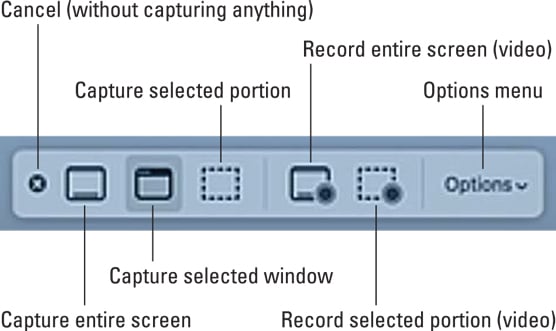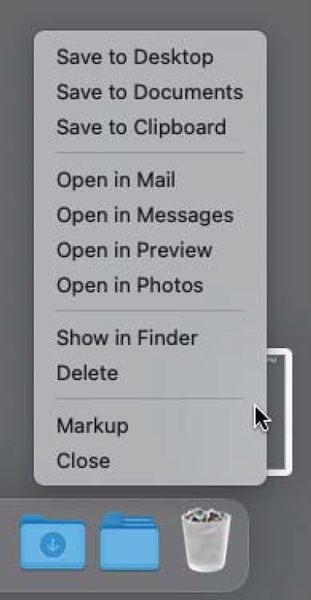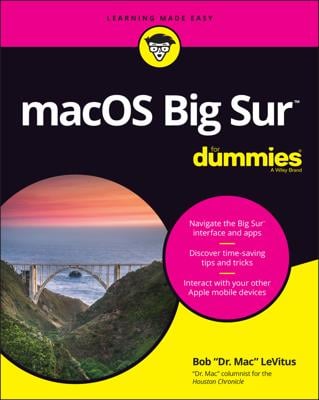In its place, Big Sur (like Mojave before it) has more and better screen-shooting capabilities than any version of macOS before it. It’s now called Screenshot and its functionality is woven into the fabric of Big Sur itself. Furthermore, Screenshot has been updated in several useful ways since it was known as Grab.
I’ll tell you about all the newish features and where to find them in just a moment. But I’d be remiss if I didn’t point out that all of your old favorite keyboard shortcuts for screen capture—the ones you’ve known and loved on the Mac since time immemorial—still work the same as always:
To capture the entire screen:
- Press Command +Shift+3.
- There is no Step 2.
- Press Command +Shift+4.
- Move the pointer (crosshair icon) to where you want to start the screenshot.
- Press the mouse or trackpad button, then drag over the area you want to capture.
- Release the mouse or trackpad button to capture the selected area.
To capture a window or the menu bar:
- Press Command +Shift+4 and then press the spacebar.
- Move the pointer (camera icon) over the area you wish to capture; when it is highlighted, click to capture the selected item.
To capture a menu and its title:
- Open the menu to display the menu commands.
- Press Command +Shift+4.
- Drag the pointer (crosshair icon) over the entire menu.
If you want to exclude the menu’s title, press Command +Shift+4, press the spacebar, move the pointer (camera icon) over the menu to highlight it, then click.
Big Sur screen-shooting 101
In addition to the old, familiar screenshot shortcuts, Big Sur has another keyboard shortcut that includes everything you can do using the other shortcuts and more.That fabulous shortcut is Command +Shift+5, and you’d be wise to memorize it because, like the other two screenshot keyboard shortcuts, it doesn’t appear in any menu or application. If you’re going to memorize only one shortcut for screen captures, it should be Command +Shift+5, which will open the floating palette of screen-shooting options shown.
 Here’s what you’ll see (more or less) when you press Command +Shift+5 in Big Sur.
Here’s what you’ll see (more or less) when you press Command +Shift+5 in Big Sur.To capture your screen as a still image, first click the appropriate icon: Capture Entire Screen, Capture Selected Window, or Capture Selected Portion. When everything is the way you want it, press Enter (or Return) on your keyboard.
What happens next, before the screenshot appears on your desktop (by default), is a relatively new thing (introduced in macOS Mojave). That new thing is a floating thumbnail that appears in the lower-right corner of your screen.
If you do nothing, the floating thumbnail will disappear after a few seconds and the screenshot will appear on the desktop by default.
But click the floating thumbnail before it goes away and a wonderful new thing happens: A window appears with a bevy of useful tools for modifying images.
These tools are known as Markup — a systemwide set of tools for annotating PDF and image files. The tools aren’t restricted to the Mail app — you’ll also find them in the Preview app, Finder’s Quick Look windows, in the Preview pane of Finder windows (if enabled), and in Finder shortcut menus.
These same tools also appear if you click the floating thumbnail of a screenshot before it disappears.
These powerful editing tools enable you to annotate screenshots in ways never before possible without a third-party graphics app. Now you can easily add circles, boxes, arrows, and text to your screenshots, image files, and PDFs without even launching an app.
When you’ve finished annotating and editing your screenshot, click Done in the upper-left corner of the window.
Big Sur screen-shooting options
If you want to change the location where your screenshots are saved, click the Options menu, which is available after you press Command +Shift+5. The Options menu also allows you to select a timer of None (the default), five seconds, or ten seconds.Finally, the Options menu lets you enable or disable the floating thumbnail, show or hide the mouse pointer, and remember the last selection you made (for your next screenshot).
Another set of options appears when you right- or Control-click the floating thumbnail, as shown.
 Right- or Control-click the floating thumbnail and choose from these options.
Right- or Control-click the floating thumbnail and choose from these options.Note that selecting Markup is the same as clicking the floating thumbnail — it opens the Markup window so you can annotate your screenshot.
Big Sur screen recording
Screen recording — movies of your Mac (or iDevice) screens — has been around for a few years on the Mac, but it’s been buried in the QuickTime Player app. (If you want to make a movie of your iDevice screen, you’ll still need to use QuickTime Player.)Anyway, to make a movie of all or part of your Mac screen, begin by pressing Command +Shift+5. Then click either the Record Entire Screen or Record Selected Portion. If you click Record Entire Screen, the recording begins immediately; if you click Record Selected Portion, you need to drag the onscreen handles to select the area you want to record, and then click the Record icon.
To end the recording, click the Stop Recording icon in the menu bar, as shown.
 The Stop Recording icon appears in your menu bar while you’re recording the screen.
The Stop Recording icon appears in your menu bar while you’re recording the screen.When the floating thumbnail appears in the lower-right corner of your screen, you can right- or Control-click it for additional options, or do nothing to have the screen recording saved in your default location.

